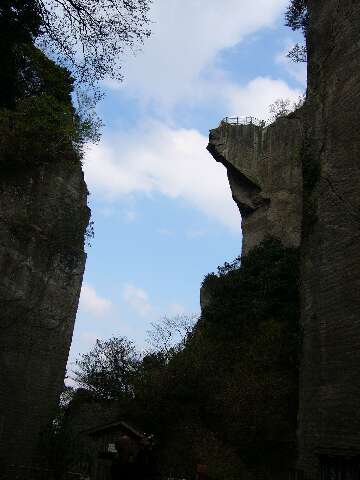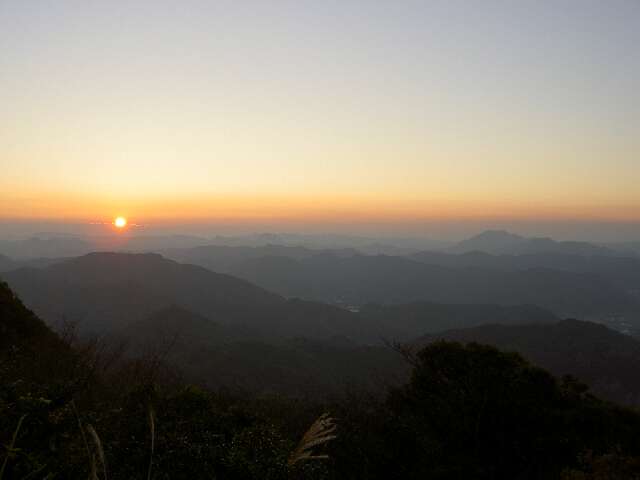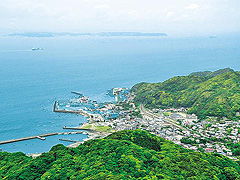
百尺観音
石を切り出した壁面に掘られた100尺(30.3m)の大観音石像は、昭和41年(1966)に完成したもの。交通安全の守り本尊として、神秘的な雰囲気を醸し出している。
Info
Business Hours
Price
Spot Category

思わず足がすくむ地獄のぞき
The information provided reflects the details available at the time of the survey.
Please note that facility details may change due to the facility’s circumstances, so please check for the latest information before visiting.
This content has been translated using machine translation.
Information provided by: JTB Publishing
The content uses an automatic translation service, which is not always accurate.
The translated content may be different from the original meaning, so please understand and use it.

石を切り出した壁面に掘られた100尺(30.3m)の大観音石像は、昭和41年(1966)に完成したもの。交通安全の守り本尊として、神秘的な雰囲気を醸し出している。

日本寺境内にある展望台。鋸山山頂駅の先に日本寺の西口ゲートがあり、そこを左へ登ると頂には浅間神社がある。ここからの眺めは、北は筑波・秩父、西から南にかけては富士・大島まで十州に及んだとして、この名がある。

かつて良質の石材の産地として大量の石が切り出され、ギザギザの岩肌が珍しい。山の南斜面には約1300年前に開かれた関東最古の勅願所・日本寺がある。拝観料を支払い「地獄のぞき」や、東海千五百羅漢、日本最大の磨崖[まがい]大仏様などのみどころを回ろう。

On the occasion of the Ojō Kōki, who was appointed as the lord of Osugasō, Shimousa Province, he was invited by Shinano Suwa Taisha Shrine as the god of the lord of the territory. He has since been revered as the god of industrial development, the god of wisdom, and in recent years as the god of advanced learning. The present main shrine is of the 1853 (Kaei 6) construction, and the annual festival "Sawara no Taisai (Autumn Festival)", which takes place in October every year, is designated as a national important intangible folk cultural property.

The temple of the Tendai sect, known as Narikiri (Namikiri), is a temple of the Tendai sect that collects the thick faith of the fishing people for great fishing prayers and sea protection. The main priest, Fudō Myōō, was reportedly picked up from the sea by the wives of the fishermen of the land during the middle Kamakura period and laid them here to rest. The thatched-roofed Fudō, which houses Fudō Myo, is designated as a national important cultural property, and is presumed to have been erected during the Muromachi period.

Western-style Mie-bashi, a masonry method, on the lower Nagao River at Takiguchi, Shirahama. Because there are three arches, it is not really glasses, but it has come to be called a glasses bridge from the appearance of moving to the river. The bridge was built in Meiji 21 (1888) with a donation of 399 yen and 40 yen from the villagers. He said he had walked across the river before the construction. It is a sturdy bridge that, in wartime, tanks passed through it without being broken by the Great Kanto Earthquake. Repair work was carried out in 1977 and 1993, and the figure remains at the time of construction. Prefectural Designated Tangible Cultural Property. Japan's Meihashi Hyakusyo.
This website uses cookies so that we can provide you with the best user experience possible. Cookie information is stored in your browser and performs functions such as recognising you when you return to our website and helping our team to understand which sections of the website you find most interesting and useful.
Strictly Necessary Cookie should be enabled at all times so that we can save your preferences for cookie settings.
If you disable this cookie, we will not be able to save your preferences. This means that every time you visit this website you will need to enable or disable cookies again.
